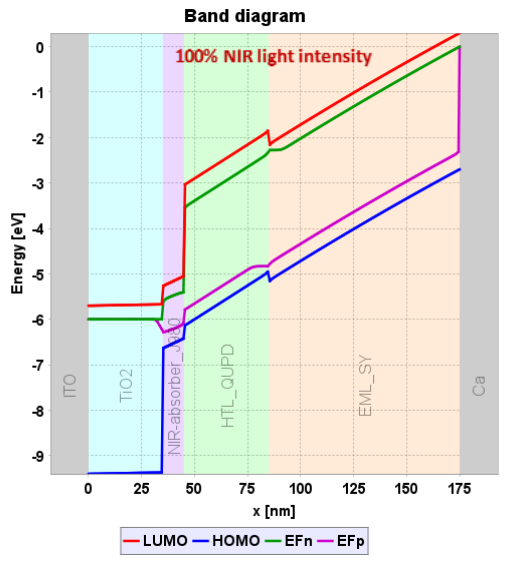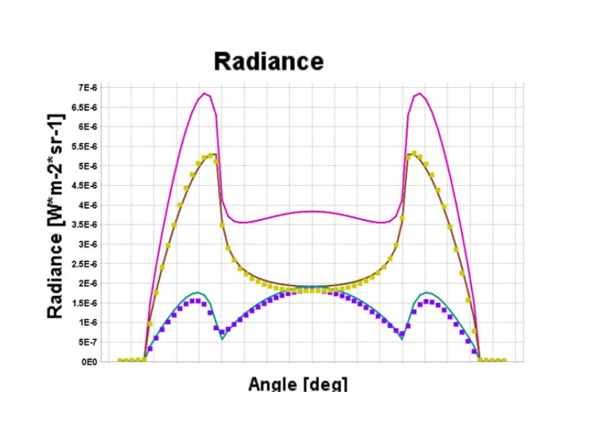
Research Blogs

A Tutorial on Drift-Diffusion simulations
We prepared a tutorial to summarize the fundamental equations to simulate the electrical behaviour of OLEDs, photodetectors and solar cells. We take as an example the response speed of narrowband organic optical upconversion devices.

Angular Resolved Photoluminescence and Electroluminescence of light emitting materials
Setfos can analyze angular-dependent PL data collected by Phelos to get information about the properties of an organic emitter, such as the orientation of the dipoles and the width of the emission zone. With this analysis, we are able to optimize the characteristics of our OLEDs for high EQEs.

Current Losses Caused by Mobile Ions in Perovskite Solar Cells
The presence of ions limits the charge extraction in perovskite solar cells, causing current losses. We used drift-diffusion simulation to validate this hypothesis and propose solutions to limit their influence – hence optimizing the power conversion efficiency (PCE).

Quantification of trap states by thermally stimulated current in thin film solar cells
The performance of light-emitting (LEDs) and photovoltaic (PV) devices depends on the quality of the photoactive semiconductor material. The unintentional introduction of defects in the semiconductor material due to material impurities or during the fabrication process causes the deviation from optimal performance.
These defects are referred to as trap states, or in short “traps”, which are energetic states within the bandgap of a semiconductor. In general, traps can occur due to material impurities (in the bulk) or at the interfaces between layers of different materials.
In the following blog post, we will present how to characterize the trap states with the technique called thermally stimulated current (TSC). We also propose a method to reliably interpret the TSC results based on drift-diffusion simulations.

Influence of recombination rates on transient photoluminescence and efficiency of TADF OLEDs
OLEDs made by thermally-activated delayed fluorescence (TADF) materials as emitters promise an IQE of 100%. Here, we want to present an analysis of the influence of non-radiative recombination rates (knrs and knrt) on the device efficiency as well as how to determine them from experiments. As we will see, the knr rate influences PLQY, and consequently ELQY, hence the negative impact on EQE.
First, to determine the non-radiative decay rates, we need to extract the rates kf, krisc, and kisc by fitting transient photoluminescence (trPL) measurements of TADF films.

ISOS protocols for stability analyses of Perovskite Solar Cells
How do we perform aging experiments that are tailored to emerging PVs? This blog post summarizes the crucial guidelines that have been proposed by the community working on Perovskite Solar Cells (PSCs) to properly assess the stability of PSCs. These guidelines have been added to the existing indications provided by the ISOS protocols developed for Organic Solar Cells.

Impact of Photon Recycling on the Efficiency of Light Extraction in Metal Halide Perovskite Light Emitting Diodes
We introduced a theoretical treatment of photon emission and recycling in optoelectronic semiconductor devices that is free of non-physical divergencies. Here, we now show the application of this framework to the assessment of the impact of PR on the light extraction efficiency in perovskite LEDs. This treatment goes from the analysis of contributing photonic modes in single emitter slab configurations to the evaluation of the external LED quantum efficiency in realistic device stacks.

Fitting routine for a reliable transient photoluminescence simulation of perovskite films
Transient photoluminescence (trPL) characterization experiments allow to analysis charge carrier dynamics and identify the recombination channels of the device structure under investigation.
Useful information that can be extracted includes the quantification of radiative and non-radiative lifetimes, charge carrier extraction from differential lifetime computation, and the influence of the interfaces on the recombination mechanism. Fitting the experimental results with simulations further supports the analysis of the obtained data. However, qualitatively comparable fittings can be obtained with different sets of simulation parameters.
Using the fully-coupled, 1-dimensional optoelectronic simulation software Setfos, the trPL signal of a simple glass/perovskite structure was simulated and a routine is suggested to ascertain the reliability of the results. This routine is based on experimentally measured material properties and the analysis of the band diagram evolution during the photoluminescence transient. The validity of the simulated trPL is also recursively verified by fitting the decay with a bi-exponential function to extract the lifetimes of the recombination mechanisms.

3D Master Equation for Exciton dynamics in oleds
We describe a novel simulation approach for excitons in organic light-emitting diodes (OLEDs). We combined a 1D drift-diffusion model with a 3D master equation.
Our approach effectively combines the computational efficiency of a 1D drift-diffusion solver with the physical accuracy of a discrete 3D ME model, where excitonic long-range interactions for energy transfer can be taken into account.
We show that such a hybrid approach can efficiently describe the steady-state and transient behavior of typical OLEDs reported in the literature.

Optimize Hyperfluorescent and TADF OLEDs by Reducing Excitonic Loss Channels
We present a combined experimental/simulation analysis of a set of 4 OLEDs with 2 systematically varied guest dopants in the EML. A numerical electro-optical model is employed, demonstrating one consistent parameter set that describes both steady-state and AC characteristics of all devices. The model accounts for charge transport, trapping, polar layers, and excitonic loss processes. These are inducing an efficiency roll-off that can be correlated with the shape of the emission zone and the guest dopant concentrations. Furthermore, starting from the resulting parameter set, we show routes for optimized TADF OLDEs with a reduced roll-off.

HOW To optimize the CIE coordinates of a blue oled by fine tuning the cavity
In this tutorial, we are demonstrating how to use the optical module of Setfos in order to demonstrate how much the color point of a full OLED can be tuned for a given emitter spectrum. Moreover, we compare the efficiency of the color-optimized device with the one that is tuned for the highest outcoupling/radiance and analyze the consequent trade-off between color purity and efficiency.
The same analysis and optimization can be performed for other types of emitters such as quantum dots or perovskites. Despite the narrow emission spectra of these emitters, the optics of such QLEDs and PeLEDs is equal to the well-established OLEDs.

Why Perovskite Solar cells with High Efficiency Show Small iV-curve Hysteresis
In many perovskite solar cells, hysteresis is observed between the forward and reverse current-voltage (IV) scans. This IV curve hysteresis can be problematic for the correct determination of the Power Conversion Efficiency (PCE). While the exact origin of the IV curve hysteresis has remained a topic of debate, it is now widely accepted that mobile ions are the principal cause. However, it is still the subject of ongoing debates about how exactly mobile ions influence the device operation.
In this blog, we are showing how a proper drift-diffusion simulation can help in understanding how mobile ions are affecting the JV characteristics of a perovskite solar cell.

Analysis of TADF OLED degradation by combining advanced characterization and simulation
Despite the success of OLED displays in commercial products, there are still issues regarding the efficiency and lifetime of these devices. It is of utmost importance to better understand the device physics in general and the origins of degradation in these OLEDs.
In this blog post, we show you an example for which we used our tools Paios and Setfos to understand device limitations and analyze the degradation mechanisms in state-of-the-art sky blue TADF OLED devices.

EQE optimization For a Top-Emitting OLED
The external quantum efficiency (EQE) is the number of photons emitted by an OLED per number of injected charges. Photons are generated in the device emitting layer (EML), but most of the light is not escaping the device because of thee main loss mechanisms: Total Internal Reflection, Absorption Losses and Surface Plasmon Polaritons (SPPs). In this example, we are showing how to use Setfos to optimize the geometry of an OLED towards high light-outcoupling efficiency.
Increase the efficiency of a Perovskite-Silicon Tandem Solar Cell with a Full Electro-Optical Simulation
The emerging solar cell technology of perovskite solar cells already reach an efficiency of 25.5%. The advantage of perovskite solar cells is that they absorb light better in the visible part of the spectrum whereas silicon-based solar cells can absorb near-infrared photons as well. This means that by combining these two technologies in tandem multi-junction solar cells, it will be possible to absorb light over a wide range of the spectrum very efficiently. Theoretically, efficiencies up to almost 40% are expected to be possible.
In this blog post, we will show how SETFOS can be used to analyze a tandem solar cell optically as well as electrically. This simulation approach reveals bottlenecks in the optimization and shows pathways for improvement. This study has been presented at the EUPVSEC 2020 by Urs Aeberhard.

Numerical Optimization of Organic and Hybrid Multijunction and Tandem Solar Cells
We present a numerical optimization of organic and hybrid multijunction solar cell devices , using an integrated optoelectronic device simulation approach that captures the essential properties of the complex multilayer structures, such as, light scattering at both macroscopic and rough thin film textures, resonator effects in coherent stacks, and the impact of organic interface properties for the design of efficient recombination layers . The optimization capabilities of the numerical device simulation framework are illustrated in the examples of textured perovskite silicon and all organic tandem solar cells.
